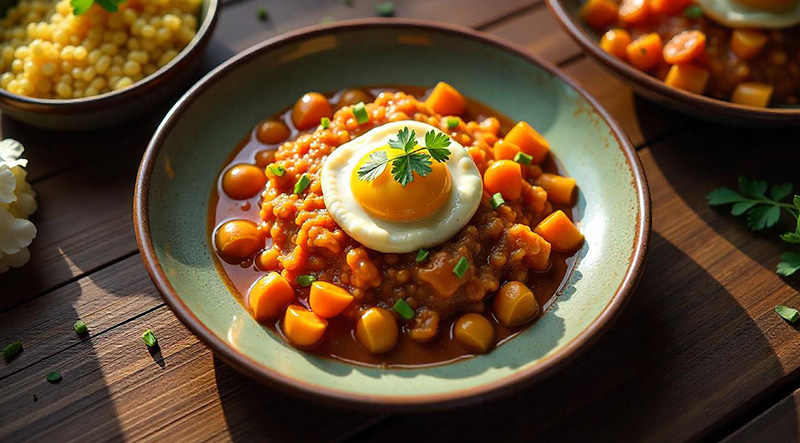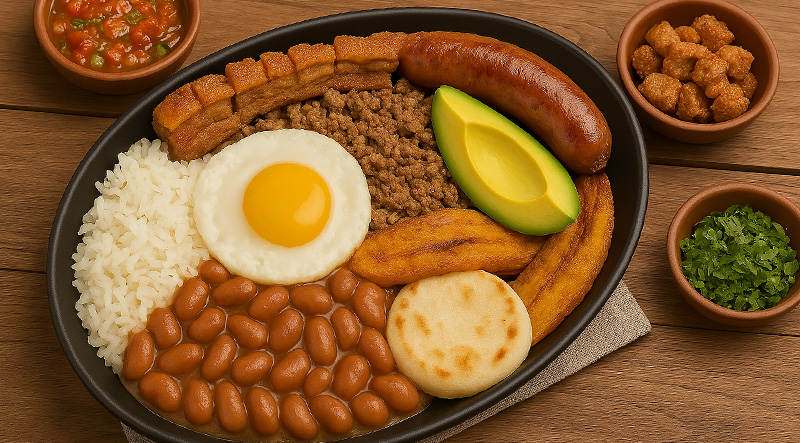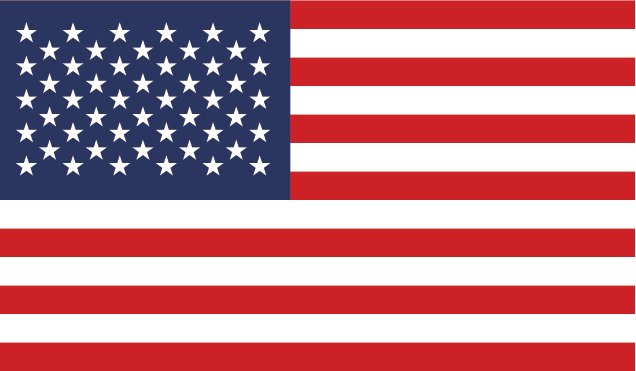Big, bold, and bursting with flavor, Bandeja Paisa is Colombia’s ultimate comfort feast—a dish so generous it’s practically a challenge to finish! Hailing from the lush Antioquia region, this hearty platter is a carnivore’s dream, featuring grilled steak, chorizo, crispy pork belly (chicharrón), and a fried egg, all nestled beside creamy beans, fluffy rice, sweet fried plantains, avocado, arepa, and tangy sauces. Every bite is a delicious journey through Colombia’s rustic, vibrant culinary soul, making Bandeja Paisa not just a meal, but a full-on celebration on a plate. Read More...
The History of Bandeja Paisa – Colombia’s Mountain-Sized Meal of Tradition and Pride:
Bandeja Paisa is more than a dish—it’s a statement of identity, heritage, and pride for Colombians, especially those from the Antioquia region in the northwestern part of the country. Known for its abundant ingredients and generous portions, Bandeja Paisa is a culinary reflection of Colombia’s rural roots, immigrant influences, and cultural heartland. Its history is a flavorful journey shaped by humble beginnings, hearty appetites, and a deep sense of regional pride.
Origins in Antioquia – A Peasant’s Power Meal:
Bandeja Paisa finds its origins in the Paisas, the people of the Antioquia region, known for their hardworking, mountain-dwelling lifestyle. This meal was developed to meet the high energy needs of farmers and laborers, offering dense, protein-rich and calorie-heavy sustenance to fuel long days of manual work. Unlike gourmet cuisine crafted in palaces or restaurants, Bandeja Paisa was born in rural kitchens, where practicality and nourishment were key.
The “bandeja”, or tray, refers to the large, flat serving platter used to fit the many components of the meal. The dish was originally a combination of local staples: beans, white rice, ground meat or beef, fried plantains, arepas (corn cakes), and a fried egg—later evolving to include chicharrón (crispy pork belly), avocado, and morcilla (blood sausage).
A Blend of Cultural Influences:
Like many Latin American dishes, Bandeja Paisa reflects the region’s multi-ethnic heritage. Indigenous peoples contributed foundational ingredients like maize and plantains. The Spanish colonizers brought pork and cattle, introducing chorizo, beef, and sausage-making traditions. African influences are also evident in cooking methods like frying and the use of beans and plantains. This blending of traditions created a dish that’s both rooted in local life and enriched by global history.
Modern Recognition and National Symbol:
Though it originated in Antioquia, Bandeja Paisa has become a symbol of Colombian identity across the country. In the 20th century, especially during the rise of national tourism and cultural branding, it was promoted as a national dish to represent the warmth, abundance, and flavor of Colombian cuisine.
Despite not being officially declared the sole national dish (as Colombia recognizes regional diversity), Bandeja Paisa is arguably one of the most internationally recognized and patriotically embraced Colombian meals.
A Feast That Tells a Story:
Today, Bandeja Paisa is served in homes, street-side eateries, and upscale restaurants alike. While modern versions may swap or lighten ingredients, the dish remains a celebration of tradition. Each component tells part of Colombia’s story—of farmers and immigrants, of flavor and resilience, of pride in one’s roots.
Whether enjoyed in the Andean highlands or a bustling city café, Bandeja Paisa is a meal that satisfies the stomach and nourishes the spirit. It’s not just food—it’s Colombia on a plate.
Cook the Beans (if using dried beans):
Prepare the Rice:
Fry the Plantains:
Cook the Chicharrón:
Alternatively, use oven or air-fryer to reduce oil use.
Prepare the Ground Beef:
Cook the Chorizo (and Morcilla, if using):

Fry the Eggs:

Assemble the Bandeja Paisa:
Enjoy your Bandeja Paisa!
It’s a dish made to impress—hearty, rich, and full of Colombian soul.
The total preparation and cooking time for Bandeja Paisa is approximately 2.5 to 3 hours, depending on whether you use dried or canned beans. Preparing dried beans from scratch takes the longest, requiring overnight soaking and about 1.5 hours of simmering. Active preparation—including cooking the rice, frying plantains, preparing chicharrón, sautéing ground beef, cooking chorizo and eggs, and assembling the platter—takes about 1.5 hours. If using canned beans and pre-cooked arepas, you can reduce the total time to around 1.5 to 2 hours, making it manageable for a weekend or special occasion meal.
A single serving of Bandeja Paisa, based on the recipe provided and typical portion sizes, contains approximately 1,200 to 1,500 calories. This calorie count includes one fried egg (about 90 cal), white rice (200–250 cal), red beans (150–200 cal), ground beef (250–300 cal), chicharrón (300–400 cal depending on fat content), fried plantain (150–200 cal), a chorizo link (150–200 cal), avocado slices (80–100 cal), and an arepa (90–120 cal). Frying and rich protein portions increase the total, making this a very hearty, energy-dense meal ideal for a large, satisfying lunch.







